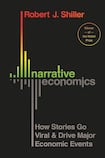
The American economist Robert Shiller is conspicuous in his achievements to liberate economics from an unquestioning adoration of free markets. His prediction of a collapse in the American housing market, and a consequent banking crisis, was a rare warning in advance of the 2008 crisis.
Shiller received the Nobel Prize for Economics in 2013. Animal Spirits (2009) and Irrational Exuberance (2010) are accessible high points of his efforts to re-integrate an appreciation of irrationality and emotion into economic decision making. Narrative Economics is the latest in this sequence.
This concept has two elements. First, the spread of ideas through stories. Second, how some stories become contagious, ricocheting through societies and influencing behaviour.

The author argues for the “moral imperative of anticipating economic events” and that “by incorporating an understanding of popular narratives into their explanations of economic events, economists will become more sensitive to such influences when they forecast the future”.
The explanation for the spread of narratives is not found in the study of literature or heritage. The author instead turns to the study of bacteria and viruses for relevant insights.
A brisk study of the catastrophic spread of Ebola establishes a basic principle: the contagion rate, or the rate of increase in infection, must exceed the recovery rate plus the death rate for an epidemic to spread.
Stories similarly spread: the more people who know, and the more they tell, the greater the prospects of a narrative going viral. A decline in relevance and the impact of other stories, thankfully, takes the place of mortality.
Contesting narratives
The chapters on “perennial economic narratives” are central to this work. These narratives “affect economic behaviour by changing the popular understanding of the economy, by altering public perceptions of economic reality, by creating new ideas about what is meaningful and important and moral”.
Nine are considered, age-old and familiar. Concepts included are that automation will cause mass unemployment, businesses or unions are malevolent and the tales of confidence and panic associated with stock market bubbles.
These tales are worthy of consideration. Debates about the impact of “labour saving” machines on employment at the end of the 19th century remind the reader that fears of new technology are nothing new.
An acknowledgement of a newspaper headline is not enough to explain how it matters, it is insufficient to understand how it influences events
Contesting narratives about the impact of linking the dollar to the value of gold emphasise the centrality of economic debates in political discourse.
There is value in understanding how these stories frame and influence economic debates. However, the lack of analysis of how their influence is developed makes this an incomplete evaluation.
Narrative Economics offers scant explanation of the role of technology as a transmission mechanism for economic narratives. A few paragraphs make passing note of the rise of the printing press and that “the rise of the internet and social media have all fundamentally altered the nature of contagion”.

The circulation of newspapers, the role of radio and television and the penetration of these forms of media into social life is completely absent. An acknowledgement of a newspaper headline is not enough to explain how it matters, it is insufficient to understand how it influences events.
Insufficient evidence
The role of US president Donald Trump as an immensely powerful storyteller is acknowledged. His use of Twitter and social media is not analysed. This is too significant an omission.
Likewise some of the conclusions are threadbare. The observation that “there is real analytical value to looking beyond the headlines and statistics” is hardly a revelation.
The consequences of stories, and their impact on economic events, is not robustly argued. That “the Trump narrative epidemic contributed to the upward turn in home prices in the United States starting after 2012” is an arresting claim, but there is insufficient evidence offered to support it.
The conclusion is that “narratives’ impact on the economy is regularly mentioned in journalistic circles, but often without the demands of academic rigour”. Alas, the same charge could be made of some claims in this book.
The warning that 'truth is not enough to stop false narratives' resonates with too many debates in too many democracies
It is more effective in arguing how the research of economics needs to change. Focus groups should become a more common method for understanding sentiment and how it changes.
The proposal to create a database of sermons would yield many insights. Do more intense and frequent calls for frugality actually influence consumption? We should know, for the benefit of both the preacher and those preached to.
The strongest section of this book argues for seven propositions of narrative economics. The warning that “truth is not enough to stop false narratives” resonates with too many debates in too many democracies.
Shiller has reanchored the uncertainty of human behaviour and motivation at the heart of economics. An appreciation of the magnitude of his achievement is better earned through his earlier works.











